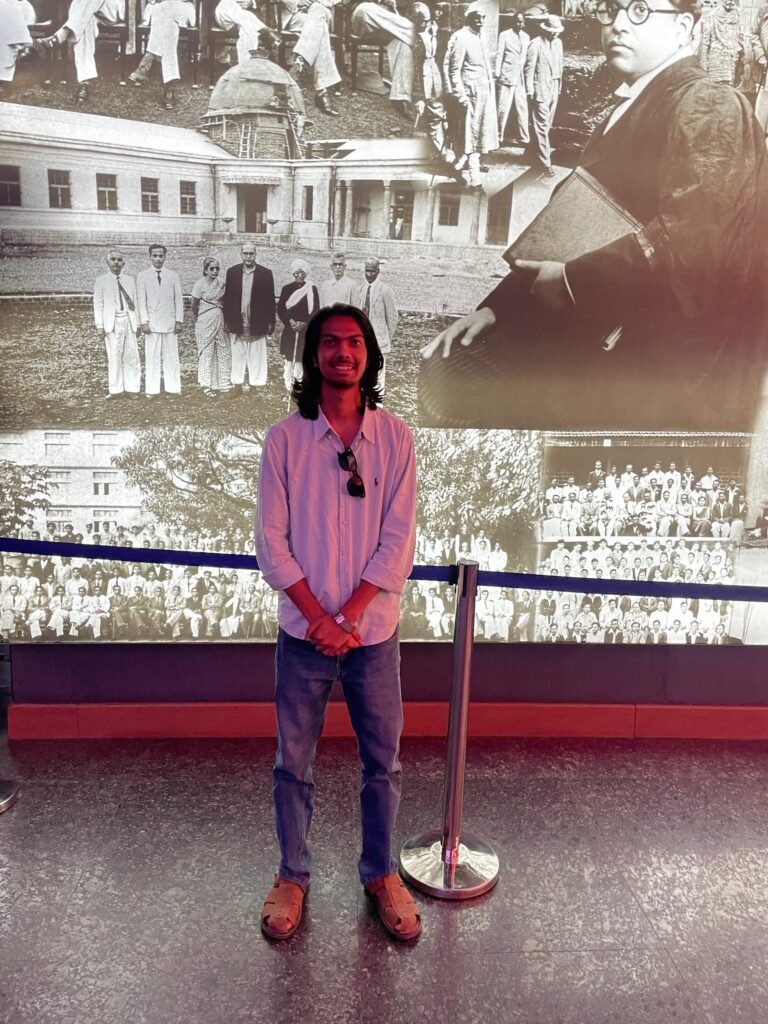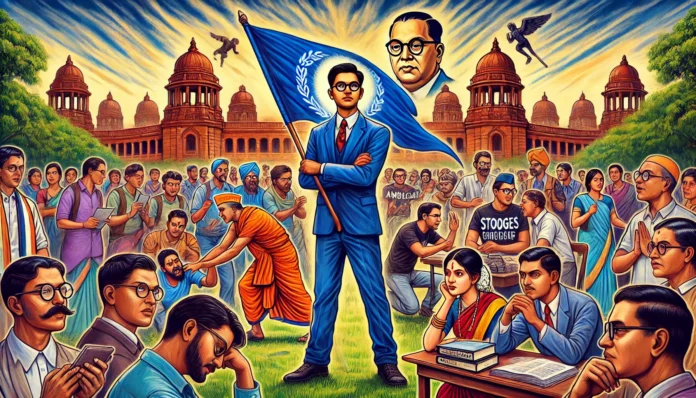Kanshiram in his book The Era of stooges (Chamcha Yug) described how Poona Pact created ‘chamcha’ or stooges. He elaborated on different types of stooges Vis-a-vis Party stooges, Caste stooges, Money stooges and Bureaucratic stooges. A Chamcha is an indigenous word for a stooge, or a tool, or an agent, who is operated by others for their own benefit. Kanshiram depicted how Gandhi felt the necessity of Chamchas from 1932-39 onwards. A Chamcha is created to oppose the real fighter, the genuine leader.
As noted by Kanshiram, how the transfer of power from Colonials to Indians and universal adult franchise or right to vote to every citizen including Dalit Shoshit created a very peculiar situation. In a democratic set up, adopted by us, the High Caste Hindus could not rule India without the consent of the Dalit Shoshit Samaj. A Similar trend is seen in university Politics, where the constitutional mandate of Affirmative action ensured the presence of Dalits and Women on university campuses, a right which was religiously and socially denied to them. Therefore, it was difficult for caste Hindus and mainstream political parties to rule without the consent and participation of Bahujans. Further it was catalyzed by social consciousness among Dalits that leaves no place for any political imagination at any level without Ambedkar. Ambedkarite and social justice politics created an imperative upon caste Hindus and mainstream political parties for the representation of Bahujans
Who are Chhatra Chamche?
However Kanshiram may not have thought of new variants in stooges which have emerged in university campuses or modern spaces of higher education. They are what I call ‘Chhatra chamche’. A Chhatra Chamcha looks for individual material and economic progress compromising over group rights. A Chhatra Chamcha has wrong priorities, it runs after limelight, ignoring the material and social reality of one’s community. Chhatra chamcha remains intoxicated under personal political influence and remains alienated from the goal of social transformation. They can compromise education, social progress and material progress for symbolic significance which in my understanding is the wrong approach in the Ambedkarite Movement. They tend to fool Bahujan students by portraying themselves as ‘Ambedkarites’ by utilizing Ambedkarite symbols like raising ‘jai bhim’ slogans, showing Babasaheb’s portrait or merely holding blue flags however they remain isolated and unaware about real issues of educational and economic progress of community.
When a Bahujan joins student politics it’s not just an act inspired by individual aspirations but also a defense mechanism against caste and discriminatory structure of modern gurukuls. Too often Bahujans and their culture remain neglected and invisible in the mainstream sphere of campus. Bahujan students who lack social capital and cultural capital required for the influence thereby making them precarious to being neglected and unheard on campus so they join mainstream political wings who may be fundamentally opposite to the ideological tradition that Ambedkar propagated. Mainstream political wings often use strategies to capture the young Dalit-Bahujans by creating an aspirational cloud of muscle, money power, others might utilize Reformist, liberals and cultural identities to cater to Bahujan students, at last they offer pseudo leadership positions to bahujan students without any political agency and autonomy for decision making in their organizations.
Though both strategies seek no actual change in material or social conditions for Bahujans.
It is these individual aspirations combined with defense mechanisms that makes them vulnerable to be used as stooges or ‘chamche’ against their own communities and Ambedkarite Movement. The agency-less and non-autonomous Bahujan students i.e. Chhatra Chamche are a threat to the self respect movement of Bahujans, where they go on to negotiate with community dignity over personal gains. Chhatra Chamche harms the movement not only individually but also socially by creating foot soldiers over Independent social agents who have no personal responsibility for family or community at large. They cater to newcomers and freshers on campuses whom they serve with social media limelight or so-called ‘popularity’ by posting their photos on organization handles. This creates an imperative upon them to join rallies and mobilizations which means a compromise on regular studies and class attendance and in most cases of mobilizations innocent students are detained and taken into police vans. They may even have to bear lathi charge.
Misdirecting and Misrepresentation of Ambedkarite Movement
The greatest threat that Chhatra Chamche posed is that due to them, the Ambedkarite Movement is being reduced to symbolic political action, then committed effort to bring social and economic transformation in oppressed communities. Babasaheb’s dream of Agitation seems to be dissociated from ‘Education and Organising’ as this Chhatra Chamche sees no value in later terms for them. Whole Ambedkarite activism means gaining political power without the right education and proper organization. It’s this Chhatra chamche in student politics who usurped the struggles of committed Ambedkarites on the campus. They may lure Dalit-Bahujans using muscle power or money power if not so they would cloak themselves as reformists, liberals and Ambedkarites. However, they are no different from Brahmanists who pose no challenge to caste except lip service. On campus, you could find them making appeals to you based upon their cultural identity and also caste identity; however, when It comes to contribution to the emancipation of Bahujan students, they are seldom found on the ground. They could often be found strengthening their voices against the regime or protesting against popular political upheaval in the country, which, in my understanding, is another political stunt to gain personal influence as when the same political parties offer them tickets or positions, they seldom think twice to take their members.
It’s not that there are no committed Ambedkarites in campuses, they are very much there in universities finding out strategies and ways to balance Education with Activism but often, their agitation and voices are usurped by Chhatra chamche who create an imperative upon them for united political action, an idea to which these Ambedkarites may subscribe however what remains un-reciprocal is that united political action never transforms to united social and economic action for emancipation of Bahujan scholars in campus.
Hence, Ambedkarites remain in classrooms, trying to find ways to support families and to fulfil the dreams of Babasaheb, Savitri and Phule.

Jatin Mathur is a Social Anthropologist / Sociologist. He is a Sociology Master’s student at Delhi School of Economics, Delhi University. His areas of interest include Identities, Anti-caste scholarship and Social Movements.


